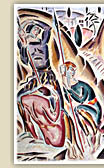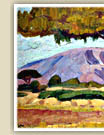|
|
 |
 |
 |
 |
 |
 |
 |
 |
 |
 |
|
"Parthenis (1878-1967), in his early attempts in various subject-matters,
|

and especially in the works of the mature and late phase of his artistic creation,
introduces new elements that allow not only the integration of Greek painting
in modern art, but also the transgression of some of its forms. His artistic creation
marks a break with conservative trends and academic forms and inaugurates
some of the bolder pursuits of the period to follow. This applies to all subject-matter
fields he is engaged with, and especially his historical, religious, mythological and
allegorical works, in which the freedom in form is applied in Greek art -for the first time to such
an extent.
What applies for Parthenis in his historical, religious, mythological and allegorical works,
is encountered in the landscapes of Maleas (1879-1928).
A painter of the natural space, he is never restricted to the representation of visual reality, but proceeds
to its individual intrepretation
|
 |

and this happens by stressing colour values and the stylization of form,
emphasis on the structural features of the subject and the inwardness of the whole. Thus,
Maleas manages to practically render a transformation of the subject with the establishment
of structural relations and functional laws, transformed into expressive values, which carry away
the spectator. With formalization and a strict design organization, the freedom of form
and the role of colour, landscapes convey something of the internal rhythm and the
expressive truth of the natural space to the spectator".
Chr. Christou, I zografiki ton 20o aiona, in Elliniki Techni, Athens, Ekdotiki
Athinon, 1994, p. 13.
|
 |
 |
|
